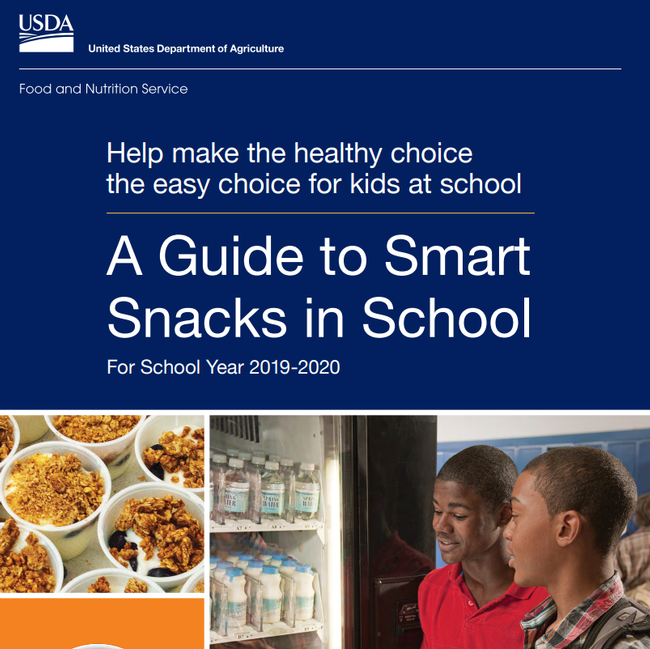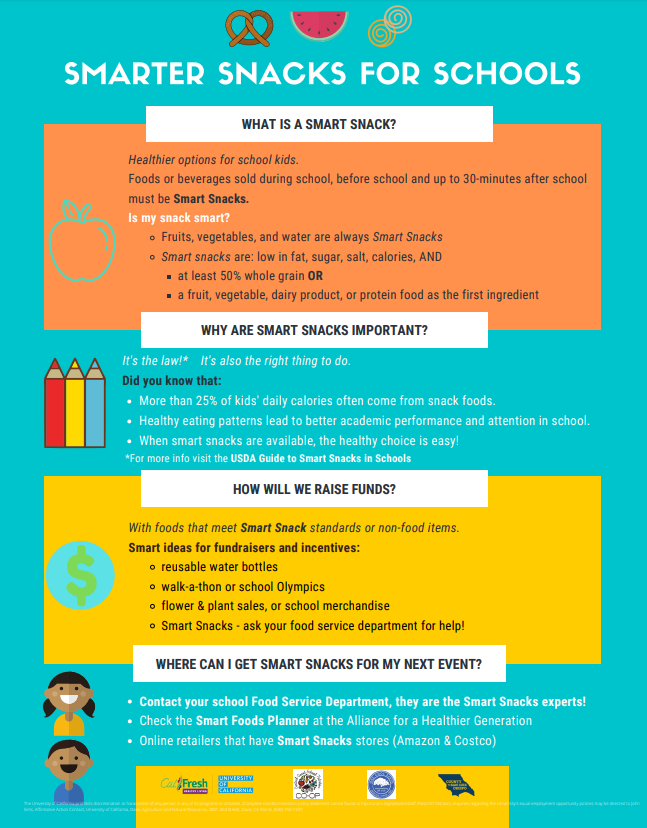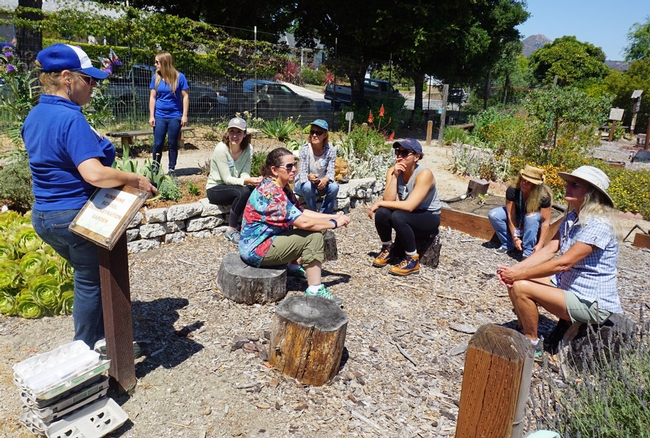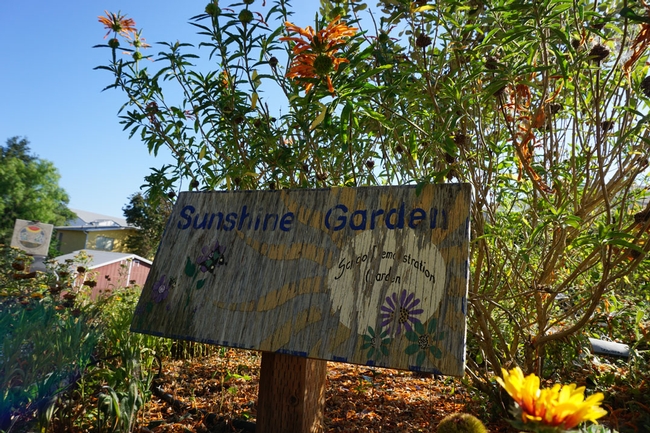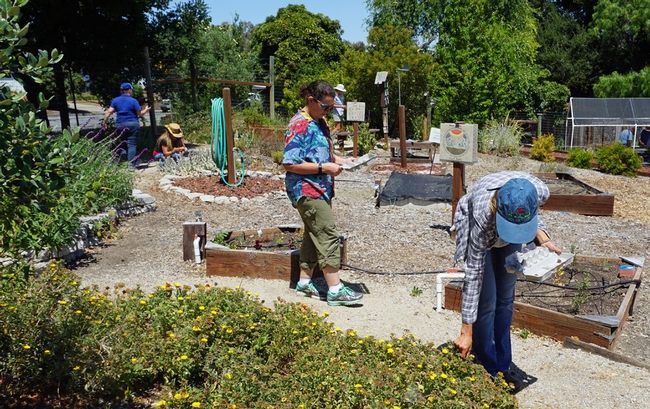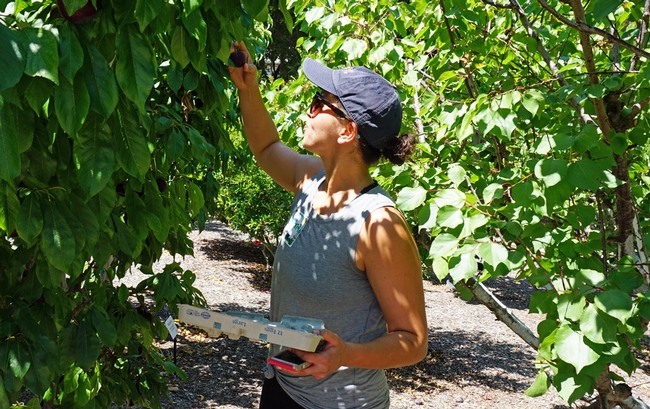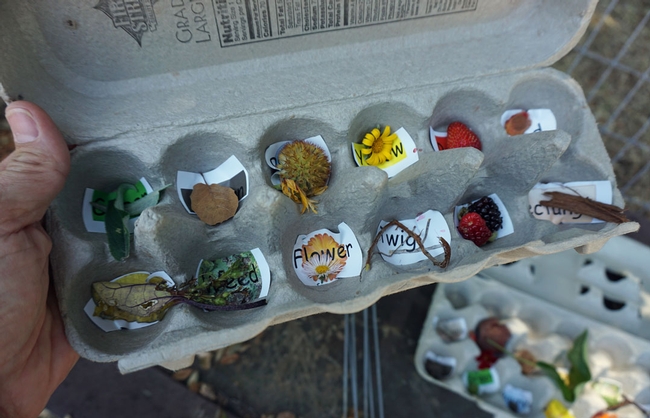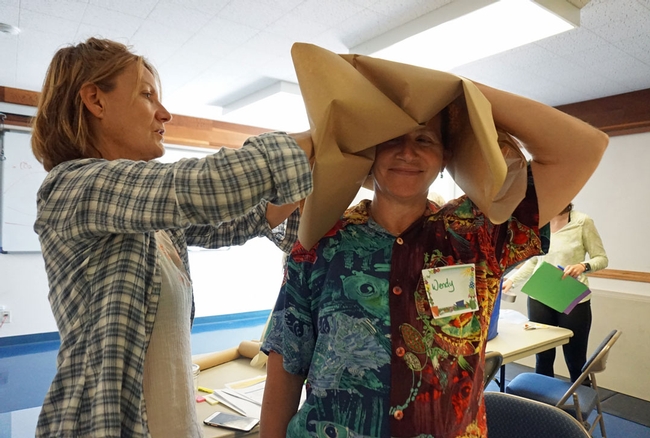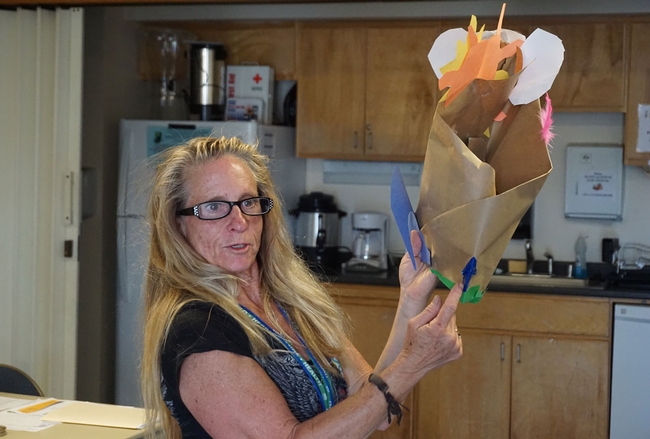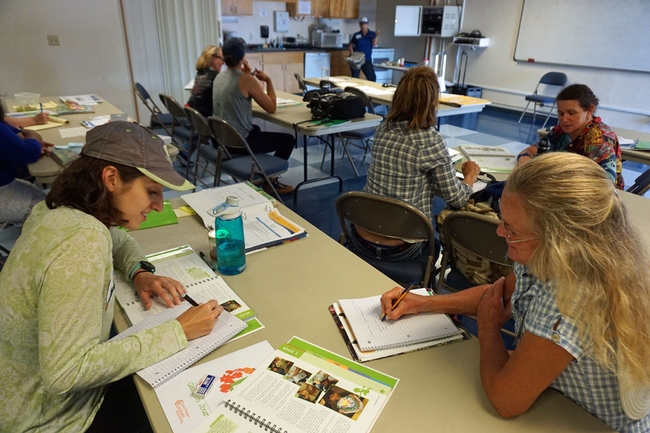Posts Tagged: Shannon Klisch
Nine academics join UC ANR during the last six months
Douglas Amaral is the new pomology, water and soils advisor in Kings and Tulare counties
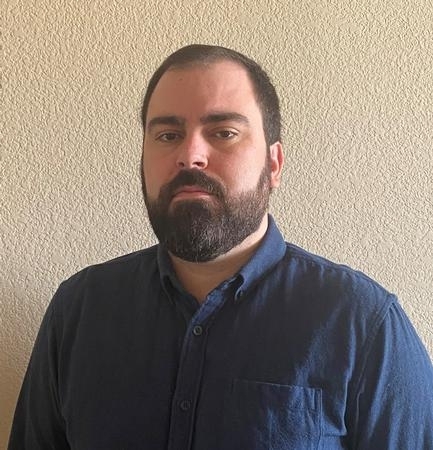
“I am very excited to be part of the UC Cooperative Extension system and am looking forward to serving growers, producers, processors, and support industries for their research and extension needs in the Southern San Joaquin Valley,” Amaral said.
Before joining UCCE, Amaral was a project scientist and postdoctoral researcher in the Department of Plant Sciences at UC Davis. His research has focused on the physiology and biochemistry of plant nutrient uptake, and molecular and genetic aspects of nutrient acquisition and tolerance in citrus, almonds, pistachios and other crops.
Amaral said he is currently meeting growers in Kings and Tulare counties and assessing their needs.
“Numerous research needs exist in the tree nut industries, including, but not limited to, irrigation and fertigation efficiency, salinity management, and water use improvement,” he said. “I believe that the most relevant scientific inquiries start with observations of the challenges faced in the field and the opinions of observant growers and the vision of industry leaders.”
Amaral, who was born and raised in Brazil, is fluent in Portuguese and English. He earned a doctoral degree in plant and soil sciences at the University of Delaware, a master's degree in plant nutrition and soil fertility at Federal University of Lavras, Brazil, and a bachelor's degree in biological sciences at University Center of Lavras, Brazil.
Amaral is based in Hanford and can be reached at (559) 852-2737 and amaral@ucanr.edu. His Twitter handle is @UCCE_DougAmaral.
Apurba Barman named UCCE integrated pest management advisor in Imperial County

"I am very excited for my new role as IPM advisor based in Southern California and for the opportunity to serve one of the most important vegetable production regions in the state,” Barman said. “The diversity and intensity of crop production in this region demand targeted research to solve pest management issues and effective extension programs to reach out diverse clientele. I feel prepared for this job with my experience and passion to serve the community.”
Barman earned a bachelor's degree at Assam Agricultural University in India, and a master's degree at Texas Tech University, Lubbock. In 2011, he completed a doctoral degree at Texas A&M University in College Station, where he worked on insect pests of cotton. Subsequently, he worked as a cotton extension entomologist with Texas AgriLife Extension Service and developed a research program to understand the extent of damage and management of thrips in the Texas High Plains region.
Barman comes to UC Cooperative Extension from the University of Georgia, where he led a whitefly monitoring and management program targeting cropping systems in the southern region of the state. Barman can be reached at (209) 285-9810, akbarman@ucanr.edu. His Twitter handle is @Ento_Barman.
José Luiz Carvalho de Souza Dias named area agronomy advisor in the northern San Joaquin Valley
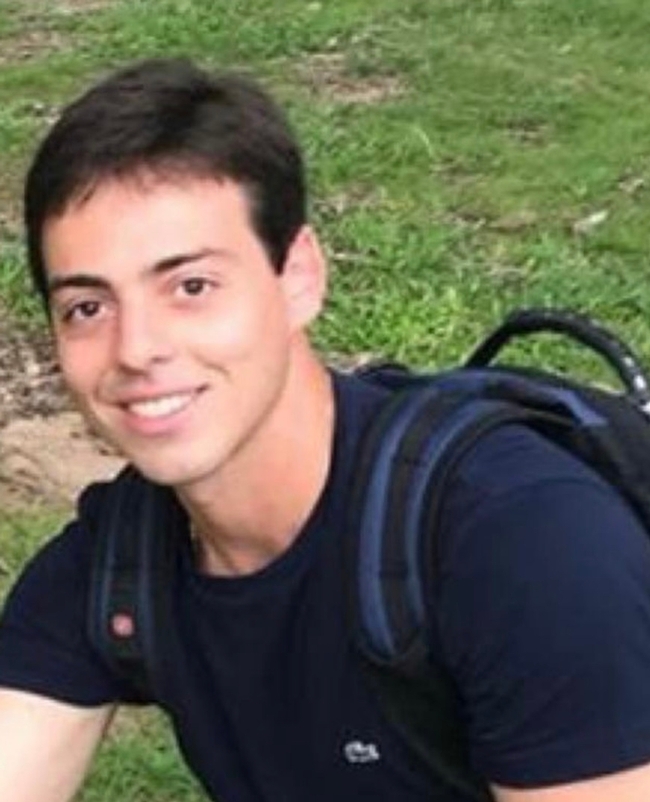
Prior to joining UCCE, Carvalho de Souza Dias was a postdoctoral researcher at the University of Wisconsin, Madison, where he worked on identifying management practices and environmental factors to ensure successful establishment of alfalfa interseeded into corn silage, sustainable management of waterhemp in established alfalfa for dairy systems, and weed control, clover selectivity and resulting yield of grass-clover mixed swards.
“I feel very fortunate to have the opportunity to work with growers, industry and academia within the agriculture industry in the Central Valley. It is amazing how diversified, complex, and productive the different production systems can be in the region,” Carvalho de Souza Dias said. “Knowing that I have the chance to work with many different challenges present in economically viable and sustainable crop production is something that makes me very excited and looking forward to the future.”
Carvalho de Souza Dias earned a doctoral degree in agronomy with a focus on weed science from the University of Florida, a master's degree in crop protection and bachelor's in agronomy from São Paulo State University in Brazil. He is fluent in Portuguese and English.
His doctoral research centered on developing and implementing integrated management practices to reduce giant smutgrass populations in bahiagrass pastures. For his master's degree, he researched herbicide selectivity in sugarcane. Based in Merced, Carvalho de Souza Dias can be reached at (209) 385-7403 and jdias@ucanr.edu.
UCCE feedlot management specialist to work at UC ANR's Desert Research and Extension Center
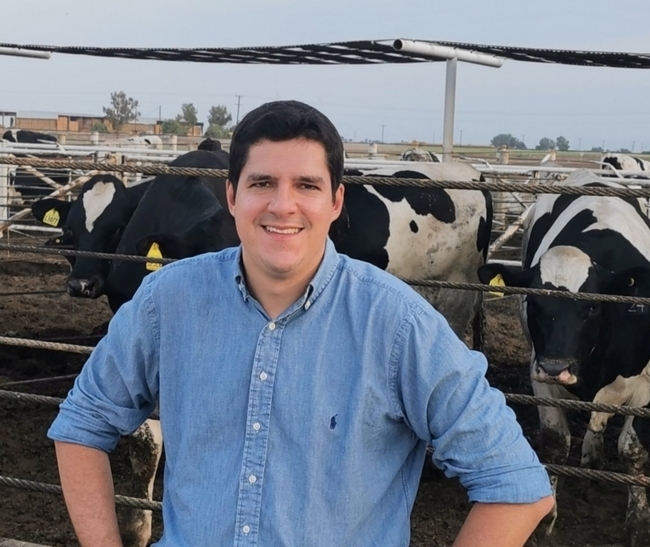
Carvalho grew up on his family's cattle and crop farm in the state of Goias in Brazil. In 2012, while an undergraduate, he came to the United States to work as an intern in the beef cattle reproduction and nutrition labs at The Ohio State University.
After earning a bachelor's degree in animal science at Federal University of Mato Grosso do Sul in Brazil, he completed a master's degree at University of Illinois, Urbana-Champaign. He recently earned his doctoral degree at Pennsylvania State University, where he conducted research projects to enhance the efficiency of Holstein steers in the feedlot.
“My plan as an extensionist and researcher at the Desert Research and Extension Center is to first understand what the needs are from our feedlot operations in Imperial County,” Carvalho told Stacey Amparano, Farm Smart manager, who wrote a Q&A with him. “After that, I plan to implement and conduct actions (research projects and on-farm training) to help our beef producers and farmworkers. I really hope that I can bring value to our stakeholders by providing information on nutrition and management, as well as helping to train and improve the lives of the workers in feed yards of our state.”
Read the full text of Carvalho's Q&A with Stacey Amparano at https://ucanr.edu/blogs/blogcore/postdetail.cfm?postnum=43442. Carvalho can be reached at pcarvalho@ucdavis.edu and (217) 418-0202. Follow Carvalho on Twitter at @pedrocattle.
New youth, families and communities academic coordinator named for Central Coast counties
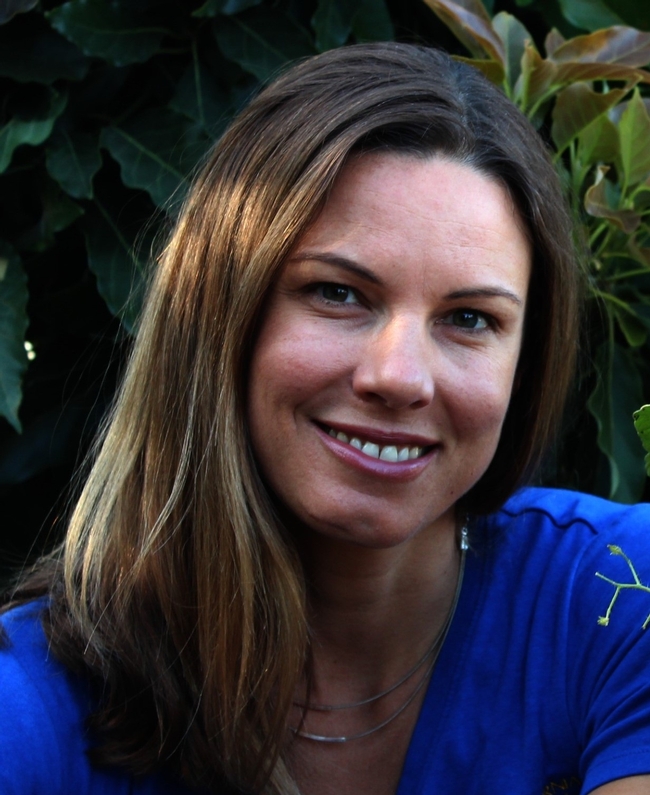
The new position was created in a reorganization, and allowed the office to maintain existing multi-disciplinary programs, including Master Food Preservers, Master Gardeners, 4-H and CalFresh Healthy Living, UC.
“I am excited to step into this new role,” Klisch said. “I know that my six years of experience managing the CalFresh Healthy Living, UC program will help inform my academic work in community health and that experience has definitely helped prepare me for taking on a leadership role in the other Youth, Families and Communities program areas.”
As community education supervisor, Klisch led the expansion of 4-H programming across San Luis Obispo and Santa Barbara counties through the UC Garden Nutrition Extender program and the 4-H Student Nutrition Advisory Council youth engagement program. Prior to joining UC ANR, Klisch worked as a private consultant with the Center for Family Strengthening.
“I am looking forward to having the time and the mandate to publish the results and accumulated data of our work in food security, positive youth development and healthy communities,” she said.
Klisch earned a master's degree in community health education at San Jose State University and a bachelor's degree in anthropology and communication from UC San Diego. She holds credentials as a master community health education specialist and community health education specialist. Klisch is headquartered in San Luis Obispo and can be reached at (805) 781-5951 and sklisch@ucanr.edu.
Gerardo Spinelli is the new production horticulture advisor in San Diego County

“Since I saw the job description for this position, I thought, ‘Wow, what a cool job!'” Spinelli said. “The agricultural setting of San Diego County is quite unique and so is this position. I'll be working with thousands of crops, ornamentals, flowers, succulents, palms. And if it wasn't enough, I also get to work with urban agriculture and a new and dynamic vegetable production industry in hydroponics. Can you dig it?”
Prior to joining UCCE San Diego, Spinelli worked for the Santa Cruz Resource Conservation District since 2015, focusing on irrigation and nitrogen management for strawberry and lettuce. He collaborated with UCCE advisor Michael Cahn to promote the adoption of CropManage, an online decision-support tool that helps farmers optimize irrigation and nitrogen application.
Spinelli also served as a visiting scientist at the University of Hawaii, Manoa, College of Tropical Agriculture and Human Resources in the late 2010s, where he designed and built hydroponic farming systems for lettuce.
Spinelli grew up in Italy on an olive and vegetable farm on the hills overlooking Florence and is fluent in Italian, English, French and Spanish. He earned a bachelor's degree in agronomy and a master's degree in tropical agriculture at the University of Florence. He also earned a master's in international agricultural development and a doctorate in horticulture and agronomy at UC Davis. Spinelli can be reached at (858) 822-7679 and gspinelli@ucanr.edu.
Tian Tian is the new viticulture advisor in Kern County
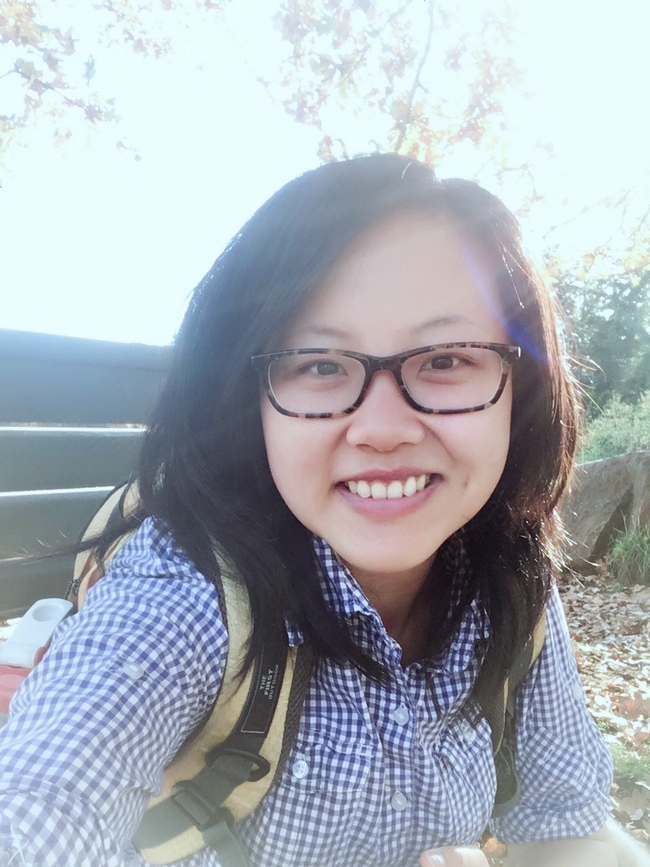
“I feel very excited to join the UC Cooperative Extension and be part of this collaborative group,” Tian said. “I look forward to working with local growers and industry to improve management practices in the vineyard and increase the profit margin of table grape production.”
Tian earned a master's degree at California State University, Fresno, and a bachelor's degree at Northwest Agriculture and Forestry University, China, both in viticulture and enology. For several years she worked in industry, including an internship at E. & J. Gallo Winery in Modesto and as the assistant vineyard manager at Berryessa Gap Vineyard in Winters.
Tian's doctoral research focused on development of better guidelines for vineyard nitrogen management for growers in the Willamette Valley. She and the research team evaluated the influences of vineyard nitrogen on vine productivity, fruit composition and wine characteristics in chardonnay and pinot noir.
Tian can be reached at titian@ucanr.edu. Her Twitter handle is @TianUcce.
Laura Vollmer is the nutrition, family and consumer sciences advisor for the Bay Area
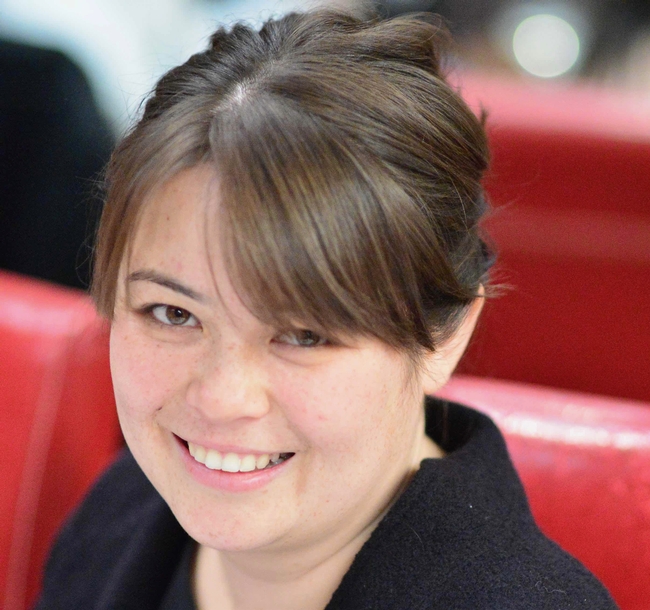
“As a multigenerational Bay Area resident (born and bred on the San Mateo County coast), it's a dream come true to serve the community that raised me,” Vollmer said. “The Bay Area has long been a leader in child nutrition and I am particularly excited for the opportunity to help implement and evaluate innovative programs that support the well-being of children and communities.
Vollmer previously worked at the UC Nutrition Policy Institute, where she helped to coordinate the National Drinking Water Alliance, a national network of allies working to ensure that all children in the U.S. can drink water in the places where they live, learn and play. She also contributed to research on food security and the charitable food assistance system, and on the impact of community nutrition and physical activity on children's health. Vollmer served as a grant writer and institutional giving associate for City Harvest, an anti-hunger nonprofit in New York City, for two years.
Vollmer earned a bachelor's degree in English at Wesleyan University and earned a master's degree in public health from UC Berkeley. She is a registered dietitian. She is a board chair of Oakland-based Youth Outside, which works to ensure equitable access to the outdoors. When she's not at work, Vollmer enjoys swimming in the ocean, cooking and hiking.
Vollmer can be reached at (650) 276-7429, lvollmer@ucanr.edu.
Grace Woodmansee is the new livestock and natural resources advisor in Northern California
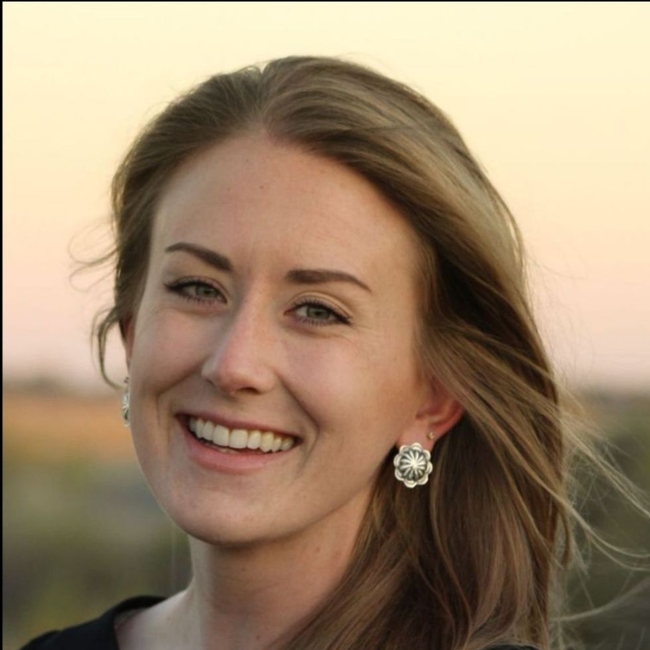
“As an undergraduate research assistant at the Chico State Beef Unit, I discovered my passion for rangeland science and management a discipline that combines my interests in social, ecological and livestock production research,” said Woodmansee. “I am very excited to join the community of Siskiyou County and to work with ranchers and land managers to identify research priorities, develop projects and address challenges related to livestock production and natural resource management.”
Woodmansee has a bachelor's degree from Chico State and completed a master's degree in agronomy at UC Davis in November. She will be based in Yreka and can be reached at gwoodmansee@ucanr.edu.

Thinner

New-hires-verticle with names

New-hires-wide with names
Smarter snacks for schools

The 2010 Healthy Hunger-Free Kids Act (HHFKA) marked the first major update to school meal guidelines across America in 15 years. Prior to HHFKA, there were no restrictions on salt, fat content in milk, or trans fats. Fruits and vegetables were grouped together, and there were no guidelines about increasing variety. In addition, snacks (i.e., competitive foods, since they compete with the school meal program) were not regulated, which meant that students could purchase junk food like candy bars and soda through vending machines right next to the cafeteria.
At the same time, childhood obesity rates were continuing to increase, along with risk factors associated with chronic diseases like heart disease and diabetes. With the updated regulations for the National School Lunch and School Breakfast Programs, millions of students across the U.S. got access to healthier meals, more in line with the Dietary Guidelines for Americans.
But what about the other foods that are available to kids during the school day? If a cookie is being sold right next to the school lunch and at a lower price, why not just buy the cookie? Or if you know your class is getting brownies from the teacher later, why get lunch at all?
The answer: New standards under the HHFKA set regulations on snacks that can be sold during the school day. Now called Smart Snacks, these food items must align with federal nutrition standards. Such standards include being at least:
- 50% whole grain OR
- having the first ingredient on the nutrition label be a fruit, vegetable, dairy product or protein food OR
- being a combination food where at least ¼ cup of the snack is a fruit or vegetable.
Many granola bars, popcorn, crackers and even treats like brownies can be a Smart Snack. Whole fruit, vegetables and frozen fruit in water or 100% fruit juice are always Smart Snacks. These standards are also required for fundraisers and events that occur during the school day, basically anytime money is exchanged for food at school. Surprising to most, the school day (for the purpose of school food regulations) actually starts at midnight before and ends 30 minutes after the last class of the day.
What makes a snack 'smart'?
Don't worry, it's not just kale chips and broccoli stalks (although kale chips and broccoli are awesome!). There are a variety of Smart Snacks that fit the taste preferences for every age range.
As parents, community partners, school boosters and school staff, we all have a role in ensuring our youth have access to healthier snacks at school. It's also the law if your school participates in the federal school meal program. To find out if the food you want to sell or give out to kids makes the smart snack grade, you can check out the Alliance for a Healthier Generation Smart Snack online calculator, where you can enter in the nutrition information from the food label. Also, large online retailers like Costco and Amazon have Smart Snacks stores where you can browse and purchase a variety of compliant Smart Snacks. These standards have been around for some time now, but many people are still unfamiliar with them or don't understand their importance.
While Smart Snacks rules only apply to food that is sold to students during the school day, other policies - like your district's Local School Wellness Policy – may govern what can be provided to students on campus through rewards and incentives or at school celebrations. So, while there are regulations about what can be sold at school during the school day, why stop there? Why not make your after school fundraiser or snack shack healthy? Why not use smart snacks instead of sugary treats? Or even better, use non-food incentives like a birthday book instead of the same sugary cupcakes that come around each time there is a birthday. Instead of selling soda for $1 with the hotdog meal at the school carnival, try sparkling water or a hydration station with fruit infused water and a prize if you bring your own reusable water bottle. Just like clothes and movies, healthy and sustainable foods are becoming more trendy and lucrative for your fundraiser!
Overall, Smart Snacks are an important complement to the national school meal program and can be a great way to help students maintain growth and success in the classroom while also helping to maintain healthy lifestyles throughout life. Let your PTA and school partners know with this new infographic.
School gardens get new life from UC Cooperative Extension volunteers
When children grow their own fresh fruits and vegetables, they are much more likely to eat healthy food, so for decades California politicians, teachers and nutrition educators have advocated for a garden in every school. However, UC Cooperative Extension experts in Santa Barbara and San Luis Obispo counties found that garden care can dwindle over time.
“Students and their parents ‘age out' of their elementary schools,” said Shannon Klisch, UC CalFresh community education supervisor in San Luis Obispo and Santa Barbara counties. “The turnover in expertise and level of commitment can vary widely, leaving some schools with either weedy, abandoned vegetable patches, or no garden support at all.”
UCCE offers UC CalFresh, federally funded nutrition education for CalFresh recipients (formerly called Food Stamps). UC CalFresh nutrition educators in Santa Barbara and San Luis Obispo counties saw a need to mobilize highly trained community members who could develop, support, sustain and teach from school gardens. UC CalFresh joined with UC's 4-H Youth Development, Master Food Preserver, and Master Gardener programs to launch a pilot project called “UC Garden Nutrition Extenders.”
“We don't have enough staff to work the gardens in every school, so we've started recruiting and training volunteers,” said Lisa Paniagua, school garden sustainability coordinator for the UC Garden Nutrition Extender program in San Luis Obispo and Santa Barbara counties.
“By enlisting passionate volunteers, nutrition educators could significantly multiply the number of students who had access to school gardens, nutrition education, and training in science, technology, engineering, and math (STEM) in the garden,” said Katherine Soule, Ph.D., youth, families, and communities advisor in San Luis Obispo and Santa Barbara counties.
Klisch said UC Garden Nutrition Extenders are local members of their school communities.
“They are often parents, neighbors or staff and they have a personal investment in seeing the youth and the school environment flourish, which makes for a much more sustainable intervention and increases community capacity to sustain a garden program," she said.
Paniagua, Klisch, and Soule created a hybrid training program integrating volunteers and educators from UC CalFresh, UC Master Food Preservers, UC Master Gardeners and 4-H. They selected a 4-H gardening and nutrition curriculum written by researchers at Texas A&M AgriLife Extension, which includes engaging, student-centered, experiential learning while dividing time between the garden and the classroom. The curriculum reinforces goals in Common Core and Next Generation Science Standards, policies that guide public school teaching.
“Teachers will want to know we are familiar with curriculum standards. Applying them adds value to these classes,” Paniagua said.
In July, the third cohort of future UC Garden Nutrition Extender volunteers gathered at UC Cooperative Extension in San Luis Obispo to learn how they can help schools transform their gardens into fruitful learning activity centers for the students.
One member of the new cohort is Jill Marie, a certified Master Gardener in San Luis Obispo County.
“I live by a school and they have garden beds that are not kept up. I want to get involved and get to know the kids,” she said.
The volunteer teachers learn by conducting the indoor and outdoor curriculum activities and food demonstrations over a four-week period. Their first foray into the UCCE Sunshine School Demonstration Garden began with a mindfulness practice.
“Close your eyes, and just listen,” Paniagua instructed. A moment later she asked, “What did you hear?”
To encourage students to take a closer look at the garden, the class was sent out with egg cartons labeled for a 12-item scavenger hunt, and later asked to select one item to discuss. Reporting on topics are part of Common Core standards for students in third- through fifth-grades and creates discussion learning topics around science, math, engineering, art, and even poetry.
Back in the classroom, the trainees began work in pairs on the next lesson, “Know & Show Sombrero.” With paper, tape and a bag of craft supplies – balloons, ribbons, foam stickers and construction paper – the extenders made hats that represent everything a plant needs. One group used a yellow balloon to symbolize the sun, another had water drops raining down from the brim. A third group sprinkled glitter to represent the nutrients in the soil.
“Why are we putting these on a hat?” Paniaqua asked the class. “The exercise is useful for kinesthetic learners. It reinforces what they learn. At the end, we talk about it and develop conversation skills.”
The half-day session ended with a tasting of purple, yellow and orange carrots.
“In your journals, write words to describe the smell, sight, taste and feel of the three colors of carrots,” Paniagua said.
One of the volunteers Christina Lawson, director of nutrition for Coast Unified School District, laughed.
“We tried to serve purple carrots. Pfft. Zip,” she said. “I'm excited about this. If the kids try them before coming to the cafeteria, it would make my life so much easier.”
This project is funded through local grant awards from the National 4-H Council in collaboration with Lockheed Martin, and UC CalFresh Nutrition Education Program, which is a joint agreement among the U.S. Department of Agriculture/Food and Nutrition Service (USDA/FNS), the California Department of Social Services (CDSS) CalFresh branch, and the University of California Cooperative Extension (UCCE).
